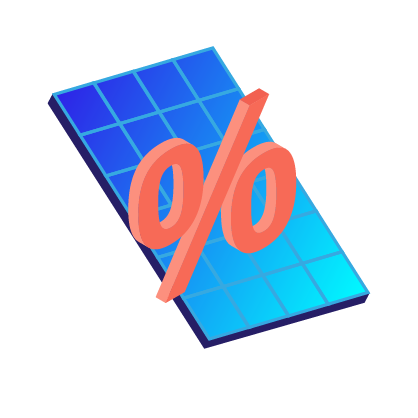How Much Energy Does a Solar Panel Produce?
One of the most important features of a solar panel is how much energy it can produce. After all, that’s what they’re designed to do!
Prospective solar panel owners usually have a goal for how much energy they want to produce. Maybe it is 100% of their household needs or even just 50%. In any case, there are a number of factors that will influence the energy production capabilities of a solar panel and how many panels they’ll need.
With the cost of solar dropping over 60% in the last 10 years and a 30% tax solar credit available to all homeowners, it is much more realistic for home and business owners to install solar panels on their property. In this post, we explore how solar panels function and produce energy.
First, let’s go over the basics.
How Does a Solar Panel Produce Energy?
Solar panels work by allowing particles of light, called photons, to knock electrons from their atomic orbitals. The electrons are captured on conductors in the form of an electric current and this electricity is harnessed and preserved. The area where this reaction occurs is called a photovoltaic cell or solar cell.
Solar panels (or modules) are made up of hundreds or thousands of these cells, and multiple solar panels make up a solar array. These arrays are connected into the existing electrical grid and/or battery storage so that the generated energy can be directed properly.
Key Solar Panel Terms: kW, kWh, DC, and AC
To fully understand the numbers, we need to go over some basic units.
- Kilowatt (kW): This is a measure of electrical power, which is equal to 1,000 watts. The electrical energy that is generated by a solar panel or a solar system can be expressed as watts or kilowatts.
- Kilowatt-hour (kWh) – A measure of electrical energy that is equal to the consumption of 1,000 watts for 1 hour. The kWh is used as a billing unit for the energy consumed by individuals. One kilowatt-hour equates to 3.6 megajoules.
- Direct Current (DC) power: This is the form of the power that gets initially generated from the panel.
- Alternating Current (AC) power: Most household appliances use AC power. The DC electricity generated by solar panels gets converted into AC so that it can be used efficiently by consumers throughout their house.
Related reading: How To Choose Solar Panels for Your Home
How many Watts does a solar panel produce?
In 2023, residential solar panels are typically rated to produce 250 to 450 Watts per hour of direct sunlight. Today, the most common power rating is 400 Watts as it provides a good balance of efficiency and affordability. A 400 Watt panel with 4.5 direct sun hours a day can be expected to produce 1,800 Watt-hours of DC electricity per day — or roughly 1,750 Watt-hours once it’s converted to AC electricity — which is more than enough to power a refrigerator and lighting needs for the average US household.
To measure how much electricity a solar panel produces you’ll need two figures:
- The solar output of the panel (measured in Watts)
- The number of peak sun hours per day (in hours) for your area
Solar panel output varies by model and ranges from around 250 to 450 Watts. The Wattage output rating represents how much energy the panel can produce per hour under standard testing conditions.
In 2023, 400W panels are considered standard, so we’ll use this output for our example.
Peak sun hours is a measurement of how much usable sunlight your solar panels receive. This varies from over 5.75 hours per day in the Southwest to less than 4 hours per day in the northernmost parts of the US. Check the peak sun hours for your location here.
Since a majority of the US gets 4.5 peak sun hours per day or more, we’ll use 4.5 hours for our example.
To calculate how much a solar panel produces per day, simply multiply the solar panel output by the peak sun hours:
400W (output) x 4.5 hours = 1,800 Watt-hours per day
We typically account for 3% loss in converting the solar energy output from DC to AC, which comes to roughly 1,750 Watt-hours. To convert to the standard measurement of kWh, simply divide by 1,000 to find that one 400W panel can produce 1.75 kWh per day.
How much energy does a solar panel produce per month?
A 400W solar panel receiving 4.5 peak sun hours per day can produce 1.75 kWh of AC electricity per day, as we found in the example above. Now we can multiply 1.75 kWh by 30 days to find that the average solar panel can produce 52.5 kWh of electricity per month.
In sunny states like California, Arizona, and Florida which get around 5.25 peak sun hours per day (or more), the average 400W solar panel can produce more than 61 kWh or more of electricity per month.

To put that into perspective, the average US household electricity uses 893 kWh per month and ranges from 537 kWh per month in Hawaii to 1,200 kWh per month in Louisiana.
So to offset 100% of the electricity usage for the average household getting 4.5 peak sun hours per day, you’d need a 6.7 kW solar system. (6.7 kW x 4.5 sun hours per day x 30 days per month = 893 kWh per month). That would require 17 solar panels with 400W output.
In sunnier locations getting 5.25 peak sun hours per day, you’d only need a 5.67 kW system made up of 14 400W solar panels to get 100% offset.
Get multiple solar quotes for your home. Start here.
Things That Affect Solar Panel Production
To get an accurate picture of solar energy output, you have to take into account a few factors like the type of panel and its environment.
As we mentioned above, the biggest factors are how many peak sun hours you get per day and the power output of the panel. However, the design of the panel matters too.
Solar energy output depends on the type of panel
There are thousands of solar panel models on the market, all with unique wattages, efficiency ratings, and degradation rates. In fact, we sorted through 750 panels available through the solar.com network of installers to identify some of the best solar panels for each category.
While there is a lot to consider, a good place to start is deciding between a monocrystalline and polycrystalline panel. Here are some features of each technology.
Monocrystalline solar panels
- Higher efficiency
- More expensive
- Better performance in high temperatures and shady conditions
Polycrystalline
- Lower efficiency
- Less expensive
- Less efficient at higher temperatures
Check this video to find out the difference between monocrystalline and polycrystalline panels.
As you can see, each type of panel has its pros and cons. Polycrystalline, however, is a newer technology and will become more efficient over time, but if you were looking to generate the most power in the smallest amount of space, monocrystalline would be the way to go.
Cover Your Electricity Needs with Solar
To sum it up, an average 400W solar panel getting 4.5 peak sun hours per day can produce around 1.8 kWh of electricity per day and 54 kWh of electricity per month.
Solar panel production varies based on the output of the panel and the available sunlight. And the amount of electricity you need from your panels depends on your energy usage and your goals. Some homeowners wish to offset 100% of their electricity usage while others are okay with less.
Regardless, electricity from solar panels is cheaper per kWh than grid electricity in the vast majority of the US. The sooner you switch to solar, the sooner you can benefit from the long terms savings and price stability.
Get started by setting savings goals with an Energy Advisor.











